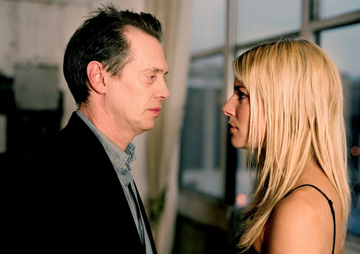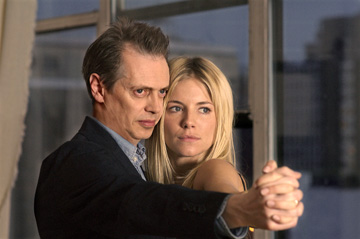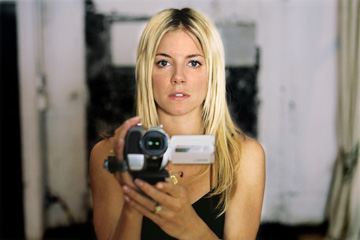 Right around the midpoint of Steve Buscemi’s uneven, ultimately disappointing Interview, the first of three American remakes of films by the slain Dutch director Theo Van Gogh (the other two will be directed by Stanley Tucci and John Turturro), Buscemi’s beleaguered, world-weary, and increasingly drunk journalist bemoans the state of his notes for his article on Sienna Miller’s catty, self-entitled celebrity-of-the-moment: “This tape is just ten minutes of us bickering at each other!” Uh, Steve, it’s more like 85 minutes. A very brief scene at the opening notwithstanding, the entire movie consists of this eponymous interview, meaning that Buscemi and Miller are bickering, cajoling, pleading, seducing, and threatening each other for the entire film’s run. This wouldn’t necessarily be a bad thing — I came in to the movie expecting a theaterish two-person character study (with possible archetypal overtones about the overlapping worlds of media and entertainment): Add one pompous reporter, one self-infatuated actress, and simmer. But, while the beginning is engaging, the ending is decent, and the film is well-made and well-acted throughout, Interview lost me in the middle going. These two characters turn on a dime too quickly too often: They go from at each other’s throats to in each other’s arms and back over and over again, and it just doesn’t feel plausible. This is mainly a fault of the writing, which — while clever — also feels stilted and unnatural. Buscemi the actor and director comes up aces here, but Buscemi the writer (along with David Schecter) frankly could’ve used a later deadline.
Right around the midpoint of Steve Buscemi’s uneven, ultimately disappointing Interview, the first of three American remakes of films by the slain Dutch director Theo Van Gogh (the other two will be directed by Stanley Tucci and John Turturro), Buscemi’s beleaguered, world-weary, and increasingly drunk journalist bemoans the state of his notes for his article on Sienna Miller’s catty, self-entitled celebrity-of-the-moment: “This tape is just ten minutes of us bickering at each other!” Uh, Steve, it’s more like 85 minutes. A very brief scene at the opening notwithstanding, the entire movie consists of this eponymous interview, meaning that Buscemi and Miller are bickering, cajoling, pleading, seducing, and threatening each other for the entire film’s run. This wouldn’t necessarily be a bad thing — I came in to the movie expecting a theaterish two-person character study (with possible archetypal overtones about the overlapping worlds of media and entertainment): Add one pompous reporter, one self-infatuated actress, and simmer. But, while the beginning is engaging, the ending is decent, and the film is well-made and well-acted throughout, Interview lost me in the middle going. These two characters turn on a dime too quickly too often: They go from at each other’s throats to in each other’s arms and back over and over again, and it just doesn’t feel plausible. This is mainly a fault of the writing, which — while clever — also feels stilted and unnatural. Buscemi the actor and director comes up aces here, but Buscemi the writer (along with David Schecter) frankly could’ve used a later deadline.
 The plot, in a nutshell, has already been described: Pierre (Steve Buscemi) is a hard-drinking, pill-popping political journalist who, as the result of being on the outs with his editor, has been assigned a celebrity puff piece in New York on the same day Very Important Indictments are being handed down in DC. (As we discover in the film’s opening moments, he also has a shell of a brother wasting away at a mental hospital. Based on later revelations, this inclusion may be important, or it may just be a red herring — I chalked it up to a need to humanize Pierre before we watch him rant and rave his way through the rest of the evening.) The celebrity in question is Katya (Sienna Miller), the It Girl of the hour for her sexual escapades and breast reduction surgery as much as for her horror film and soapy TV drama (neither of which Pierre took the trouble to screen beforehand. He considers the subject matter — and the subject — beneath him.) The official interview, at a trendy downtown restaurant, starts and ends badly. But, on the way home, an accidental bump on the head, perhaps precipitated by Katya’s winning smile, gets our two antagonists bottled up in her spacious Tribeca loft, where the “real” interview begins to unfurl…
The plot, in a nutshell, has already been described: Pierre (Steve Buscemi) is a hard-drinking, pill-popping political journalist who, as the result of being on the outs with his editor, has been assigned a celebrity puff piece in New York on the same day Very Important Indictments are being handed down in DC. (As we discover in the film’s opening moments, he also has a shell of a brother wasting away at a mental hospital. Based on later revelations, this inclusion may be important, or it may just be a red herring — I chalked it up to a need to humanize Pierre before we watch him rant and rave his way through the rest of the evening.) The celebrity in question is Katya (Sienna Miller), the It Girl of the hour for her sexual escapades and breast reduction surgery as much as for her horror film and soapy TV drama (neither of which Pierre took the trouble to screen beforehand. He considers the subject matter — and the subject — beneath him.) The official interview, at a trendy downtown restaurant, starts and ends badly. But, on the way home, an accidental bump on the head, perhaps precipitated by Katya’s winning smile, gets our two antagonists bottled up in her spacious Tribeca loft, where the “real” interview begins to unfurl…
 The remainder of this epic interview consists of seventy or so minutes of intensive, convulsive, verbal wrestling within this deluxe apartment in the sky: Buscemi’s snake to Miller’s mongoose (or is it Buscemi’s mongoose to Miller’s snake? Either way it’s bad — I don’t know animals.) Their sparring is intermittently entertaining, to be sure, but it zigs and zags too often to feel anything close to real. And, while Buscemi and Miller both do excellent work in the roles as written, other parts of the story just don’t hold up. At one point, Buscemi becomes fascinated with some morbid paragraphs he finds (surreptitiously) in Katya’s diary. But, frankly, it’s the type of gloomy woe-is-me fluff everybody had written at some point in a journal, and it doesn’t really make sense that it’d pique his interest so. And to help explain away the reason why neither Pierre or Katya disengage from this disastrous conversation much earlier, they’re given an unwieldy, simplistic Freudian connection — he looks like her wayward dad (her dad is John Waters?), she reminds him of his deceased daughter — that comes off as groan-inducing more than anything else. The last few beats of the movie help bring the story into focus, but by then the damage is done — I’d stop thinking of either character as real people, or as anything other than writerly conceits. For all intent and purposes by then, the Interview was over.
The remainder of this epic interview consists of seventy or so minutes of intensive, convulsive, verbal wrestling within this deluxe apartment in the sky: Buscemi’s snake to Miller’s mongoose (or is it Buscemi’s mongoose to Miller’s snake? Either way it’s bad — I don’t know animals.) Their sparring is intermittently entertaining, to be sure, but it zigs and zags too often to feel anything close to real. And, while Buscemi and Miller both do excellent work in the roles as written, other parts of the story just don’t hold up. At one point, Buscemi becomes fascinated with some morbid paragraphs he finds (surreptitiously) in Katya’s diary. But, frankly, it’s the type of gloomy woe-is-me fluff everybody had written at some point in a journal, and it doesn’t really make sense that it’d pique his interest so. And to help explain away the reason why neither Pierre or Katya disengage from this disastrous conversation much earlier, they’re given an unwieldy, simplistic Freudian connection — he looks like her wayward dad (her dad is John Waters?), she reminds him of his deceased daughter — that comes off as groan-inducing more than anything else. The last few beats of the movie help bring the story into focus, but by then the damage is done — I’d stop thinking of either character as real people, or as anything other than writerly conceits. For all intent and purposes by then, the Interview was over.
